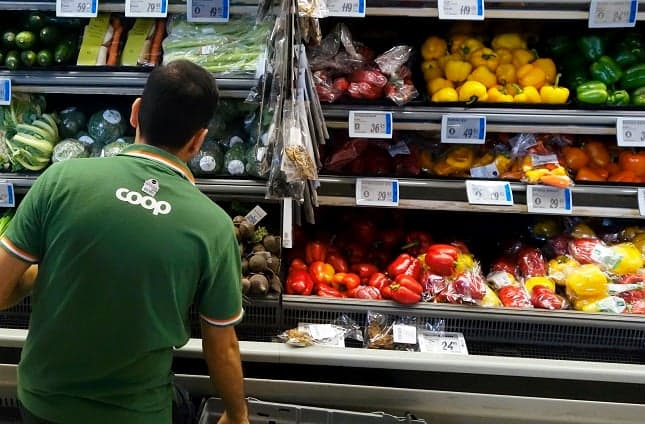These are the products that have got cheaper (and more expensive) in Sweden

The coronavirus crisis has led to falling prices in Sweden, across a whole range of categories – but food is getting more expensive.
The pandemic has had a major effect on the economy, with numerous companies forced to declare bankruptcy, hundreds of thousands of workers sent home from their jobs, and unemployment expected to rise.
At the same time, prices are falling, with inflation at a minus rate. According to Statistics Sweden, the rate of inflation, measured using the change in the fixed-rate consumer price index (CPIF), was -0.4 percent in April, compared to 0.6 percent in March.
-
How to protect your finances when the economic downturn hits Sweden
-
How to save money despite living in Sweden
Lower electricity and fuel prices had the biggest impact, falling by 16 and 21 percent respectively year-on-year, and by 5.1 and 9 percent respectively compared to the previous month. Excluding energy, the total inflation rate was 1 percent, so this category was responsible for the minus figure.
Electricity prices were already low in early 2020, due to a mild winter combined with a long period of a lot of precipitation and relatively windy weather, which left reservoirs full while helping to reduce domestic electricity use. In other words, that meant high supply and low demand.
Prices have also fallen for products in the retail and entertainment sectors, which have been hard hit by the crisis.
Clothing prices were down by 2.1 percent in April from the previous month according to the CPIF and by 3.8 percent from last year, while recreational and cultural services had fallen by 2.5 percent month-on-month and by 1.6 percent over the past year.
But when it comes to food, prices have risen and were up by one percent month-on-month and by 3.5 percent compared to last year.
This is likely due in part to increased sales in the early stages of the outbreak as people stocked up on key food items.
Fruit and vegetables have become a lot more expensive, rising in price by nine and five percent respectively. And hot, caffeinated drinks are clearly in demand, with coffee, tea and cocoa rising by close to seven percent in the space of one year.
"The corona pandemic affects society in many ways. Among other things, it has led to Swedish consumers switching large parts of their consumption. In some cases, stores have been closed and products purchased in other ways. In other cases, consumption has completely stopped," Statistics Sweden said.
"Due to non-consumption, the price trend for flights, tickets for sports competitions, cinema, theatre and entertainment has been imputed so that they do not affect the rate of inflation."
Comments
See Also
The pandemic has had a major effect on the economy, with numerous companies forced to declare bankruptcy, hundreds of thousands of workers sent home from their jobs, and unemployment expected to rise.
At the same time, prices are falling, with inflation at a minus rate. According to Statistics Sweden, the rate of inflation, measured using the change in the fixed-rate consumer price index (CPIF), was -0.4 percent in April, compared to 0.6 percent in March.
-
How to protect your finances when the economic downturn hits Sweden
- How to save money despite living in Sweden
Lower electricity and fuel prices had the biggest impact, falling by 16 and 21 percent respectively year-on-year, and by 5.1 and 9 percent respectively compared to the previous month. Excluding energy, the total inflation rate was 1 percent, so this category was responsible for the minus figure.
Electricity prices were already low in early 2020, due to a mild winter combined with a long period of a lot of precipitation and relatively windy weather, which left reservoirs full while helping to reduce domestic electricity use. In other words, that meant high supply and low demand.
Prices have also fallen for products in the retail and entertainment sectors, which have been hard hit by the crisis.
Clothing prices were down by 2.1 percent in April from the previous month according to the CPIF and by 3.8 percent from last year, while recreational and cultural services had fallen by 2.5 percent month-on-month and by 1.6 percent over the past year.
But when it comes to food, prices have risen and were up by one percent month-on-month and by 3.5 percent compared to last year.
This is likely due in part to increased sales in the early stages of the outbreak as people stocked up on key food items.
Fruit and vegetables have become a lot more expensive, rising in price by nine and five percent respectively. And hot, caffeinated drinks are clearly in demand, with coffee, tea and cocoa rising by close to seven percent in the space of one year.
"The corona pandemic affects society in many ways. Among other things, it has led to Swedish consumers switching large parts of their consumption. In some cases, stores have been closed and products purchased in other ways. In other cases, consumption has completely stopped," Statistics Sweden said.
"Due to non-consumption, the price trend for flights, tickets for sports competitions, cinema, theatre and entertainment has been imputed so that they do not affect the rate of inflation."
Join the conversation in our comments section below. Share your own views and experience and if you have a question or suggestion for our journalists then email us at [email protected].
Please keep comments civil, constructive and on topic – and make sure to read our terms of use before getting involved.
Please log in here to leave a comment.